 |
|||||||||||||||||||||||||||||||||||||||||||
|
“. . . if you search . . .
you will find buds on tree and bush, carefully wrapped around with the case which protects them as a cloak”
|
|||||||||||||||||||||||||||||||||||||||||||
|
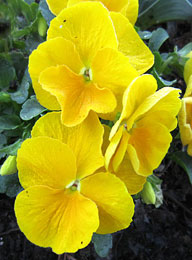 As the number of blooming things at the botanical garden picks up, so do the crowds. By midmorning a fair-sized line had formed at the admission window and the parking lot was nearly full. Can’t say it was cabin fever that drew the visitors because the winter here was very sketchy. Put it down to a fine day, relief that winter never arrived, and a need to be in on the edges of spring. As the number of blooming things at the botanical garden picks up, so do the crowds. By midmorning a fair-sized line had formed at the admission window and the parking lot was nearly full. Can’t say it was cabin fever that drew the visitors because the winter here was very sketchy. Put it down to a fine day, relief that winter never arrived, and a need to be in on the edges of spring.In some years, the keepers of the botanical garden have had to put in “cheater pansies” -- replacement pansies for the ones that were planted in the fall but never made it through the winter. This year though, no need for the cheaters. The thousands of bright yellow pansies planted last fall in the raised beds around the reflecting ponds look dazzling. They came through the winter unscathed – leaves have little frost damage and the flowers are plentiful and full-sized. A big factor in their good health was the mild winter. Another is that the pansies selected for planting in the display gardens were tested in the botanical garden’s test plots near the Kemper Center. Each fall the Garden plants over four dozen pansies and then in the spring they evaluate each variety on tolerance to the cold, flower production, growth rate, and visual appeal. The yellow pansies with the top scores were ‘Panola XP Yellow’ (a pure deep yellow with no markings), ‘Ideal Golden Lion’ (deep yellow with very light whisker markings on three petals, and ‘Venus Yellow Blotch’ (another butter yellow variety with dark money-face markings). Not coincidentally then, the yellow pansy chosen for key display gardens was among those placed near the top: ‘Panola XP Yellow.’ 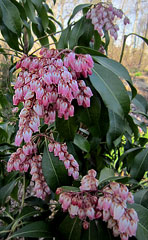 Around here Pieris japonica is a chancy shrub to keep alive. I’ve personally killed a couple. We’re in Zone 6 and the shrub is reported to thrive up to Zone 5, but even so it doesn’t care for the Midwest. Even this botanical garden admits that Japanese pieris doesn’t seem to perform well in most locations around here: “Summer foliage decline and reduced vigor results in weakened plants that may succumb to a harsh winter.” Depite bad reviews, the plant centers at the big hardware stores stock and sell a lot of them. In the stores the pieris shrubs look spectacular in their 2-gallon pots with their deep green glossy foliage, bronze-colored new growth, and grape brunch clusters of pinkish flowers. However this year the Pieris japonica ‘Shojo’ shrub in the England Woodland Garden looks even bigger and better than the ones being sold in pots. Around here Pieris japonica is a chancy shrub to keep alive. I’ve personally killed a couple. We’re in Zone 6 and the shrub is reported to thrive up to Zone 5, but even so it doesn’t care for the Midwest. Even this botanical garden admits that Japanese pieris doesn’t seem to perform well in most locations around here: “Summer foliage decline and reduced vigor results in weakened plants that may succumb to a harsh winter.” Depite bad reviews, the plant centers at the big hardware stores stock and sell a lot of them. In the stores the pieris shrubs look spectacular in their 2-gallon pots with their deep green glossy foliage, bronze-colored new growth, and grape brunch clusters of pinkish flowers. However this year the Pieris japonica ‘Shojo’ shrub in the England Woodland Garden looks even bigger and better than the ones being sold in pots.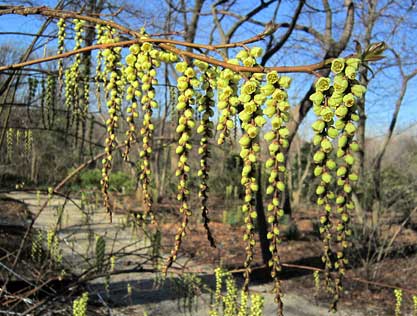 Lots of visitors are taking pictures of this shrub in the English Woodland Garden so I thought I would too. Its botanical name is Stachyurus praecox. Too bad it doesn’t have a common name. Like the Pieris japonica, the Stachyurus has a hard time making it through hard winters. The dangling strings of yellow flowers spaced so nicely on the outer banches take me back to that essential of hippie decor of the 60s – the beaded room dividers. 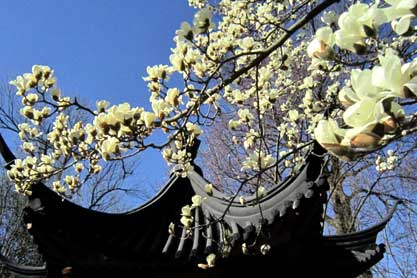 This is one those one in five great years for magnolias and this botanical is filled with them. Here’s a bit of a white-flowered magnolia tree in the Chinese Garden near the pavilion. 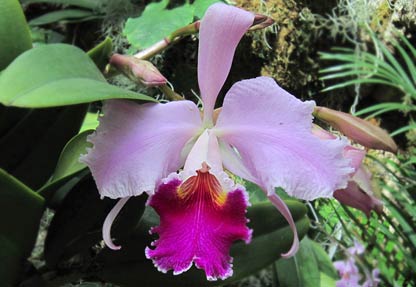 And here it is. Just arrived at the orchid show this week. An orchid that was hybridized at this botanical garden – a Laeliocattleya named ‘St. Louis.’ It was developed by horticulturist George Pring who came to this botanical garden in 1906 when he was 21 and left when he was 84. This sumptuous-sized orchid was registered by the botanical garden in 1950. That was during the time when the Garden grew orchids to supply to local florists who then sold them for weddings, society affairs, and to guys who wants to impress their prom dates. Orchid sales were so good that the profits they generated were enough to cover the costs growing and maintaining the whole orchid collection with money left over to pay for operating the garden’s 2400-acre nature reserve. I’m betting that back in the 50’s hundreds of Laeliocattleya ‘St. Louis’ orchids grew here. ‘St. Louis’ looks as though it was bred to end up as a corsage. While still on orchids, here a some comments I overhead while visiting the orchid show:
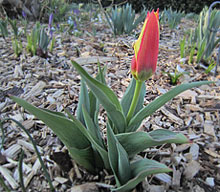 Seeing daffodils in bloom is no longer remarkable. They’re varied and plentiful all over the garden this morning. This however is the first tulip I’ve see this year. There’s no label beside the tulip maybe because the keepers didn’t expect it to flower just yet. Gregii? Kaufmanniana, maybe?
Seeing daffodils in bloom is no longer remarkable. They’re varied and plentiful all over the garden this morning. This however is the first tulip I’ve see this year. There’s no label beside the tulip maybe because the keepers didn’t expect it to flower just yet. Gregii? Kaufmanniana, maybe?Hellebores are the must-see flowers this week. The easy winter has been good to them. They’re in vigorous full bloom now and likely to stay that way. Experts on hellebores say that unlike most early bloomers that come and go within weeks, hellebores will bloom for at least two months. If the nights stay cool, they last even longer. 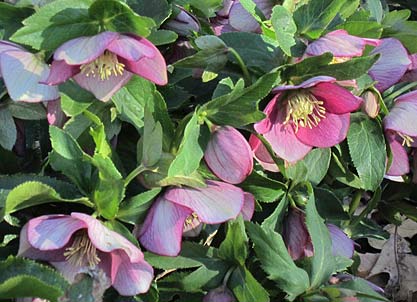 “Who could fail to be smitten with hellebores?” the authors of a comprehensive book on hellobores ask. And then, they go on to document how recent the infatuation with them is. Hellebores used to be used for dressing the wounds of livestock or for killing lice, but they didn’t belong in the gardens of anyone with taste and breeding. Their transformation into a things of beauty happened in the early 1900s when magazines anointed them as the next new exciting must-have plant and as nurseries began stocking a greater variety of hellebore species. Fast forward to today. A hellebore recently has been named plant of the year. There are nurseries that specialize in hellebores. And breeders are developing new double-flowering plants in a whole range of colors along with supersizing the blooms that now face outward. I’ve yet to see a double variety in this botanical garden but I did get an e-mail a few days ago from a nearby nursery advertising a new double named ‘Golden Discovery.’ They described it as having “elegantly beautiful, fully double large flowers with stunning shades of yellow to lime green and solid colored flowers and blossoms with speckled and spotted petals, as if painted by the most brilliant artist.” They promise that it will grow into an “evergreen mound whose ethereal blossoms create an enchanting masterpiece.” I stopped into the nursery today to have a look at ‘Golden Discovery,’ but it was sold out. The nursery owner told me next time, “Don’t wait.” She said that soon after the e-mail went out, people began arriving in a cold rain and bought every one of them. 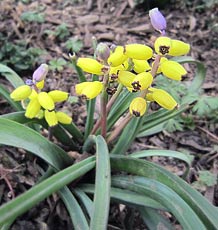 When I stooped to have a closer look at this unusual yellow grape hyacinth, I was reminded of a quote I came across in the newspaper: “The essence of winter gardening is getting down on your knees, because everything is small.” The stems on this grape hyacinth flowering in the Ottoman Garden are no more than five inches from the ground. The bulb wasn’t labeled but I found a match in Brent and Becky’s Bulbs. It’s a Muscari macrocarpum ‘Golden Fragrance.’ The tubular flowers are described as smelling like a banana rubbed on a gardenia, but because the stems are so short you’d have to be lying on the ground on your stomach to verify that.
When I stooped to have a closer look at this unusual yellow grape hyacinth, I was reminded of a quote I came across in the newspaper: “The essence of winter gardening is getting down on your knees, because everything is small.” The stems on this grape hyacinth flowering in the Ottoman Garden are no more than five inches from the ground. The bulb wasn’t labeled but I found a match in Brent and Becky’s Bulbs. It’s a Muscari macrocarpum ‘Golden Fragrance.’ The tubular flowers are described as smelling like a banana rubbed on a gardenia, but because the stems are so short you’d have to be lying on the ground on your stomach to verify that. |
||||||||||||||||||||||||||||||||||||||||||
|
+ Click to Subscribe
 | E-Mail me | E-Mail me |
|||||||||||||||||||||||||||||||||||||||||||